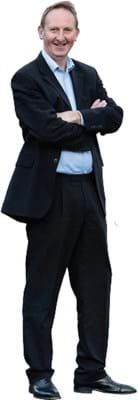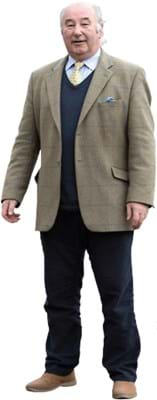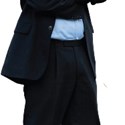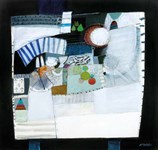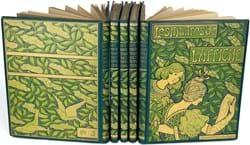Interview
BEHIND every successful trade association is a band of earnest volunteers. They sit on boards, elected to the sometimes thankless tasks of championing a craft in the wider world, prioritising member interests and navigating their rank and file through periods of economic and regulatory change.
In the sphere of art and antique dealer trade bodies, such as LAPADA, The Association of Art & Antiques Dealers, there is the added role of helping members adapt to modern business best practice, in particular to seizing the opportunities that technology offers.
So who are these passionate altruists and what happens when one of them steps down and another takes over? Late last year LAPADA stalwart and Powys-based furniture and works of art dealer Ian Anderson left the association’s board of directors. At the same time Patrick Macintosh, a Dorsetbased dealer in 18th to 20th century furniture, joined its ranks.
In the course of two wintery afternoons ATG met with each dealer, Anderson over a glass of white wine and Macintosh over a ‘cup of builders’. The two dealers talked LAPADA, the changing trade and skill involved in selling.
PATRICK MACINTOSH
Getting antiques dealers to be part of an association is difficult. Dealers are individuals by nature and geographically located far and wide, so any association that backs them up needs to be big and have back-up.
I was honoured to be asked to join the board last year – thrilled in fact. My plan is to give my input gradually, softly for now until I know how other members operate. It’s the organisation’s contemporary feel that drew me to LAPADA when I first joined in 2004, and along with attracting some younger members, I could help others with tasks like online selling.
I’m not new to the world of association boards, I was chairman of the West of England Antique Dealers’ Association (WEADA), which was run by volunteers with some parttime staff. It’s important to have a forum of members and LAPADA has plenty of ‘umph’ to back it up.
Having sat in on the committee a couple of times, the LAPADA board of directors is a good mixed bag and the sessions are well-moderated. I haven’t said much at meetings yet but have suggested doing some mentoring to get dealers with less experience into LAPADA.
Learning about the trade is a slow burn and there’s nothing like having help from inside the business when you’re starting out, no matter how cutting edge you want to be. You can look at books or online, but having someone assess an object and tell you about it – that’s the best way to learn.
I began dealing when I was about 27 and I came to it a little by chance. My father was a modern historian, my mother a professional tennis player and I did a degree in medieval history at Cambridge, so I had a historical background. But I wasn’t sure about antiques.
After university I moved to London to work as a porter at Phillips and then went to Sotheby’s where I was its agent in the West Country. I really enjoyed being in the country and when Sotheby’s started closing its regional offices, I decided to set out on my own.
I didn’t really fancy being a shopkeeper then. I had tried sales when I was younger and was terrible at it, but that’s how a lot of people come into the trade. They’ll be great salesmen and pick up their specialist knowledge as they go along. I had to work at the sales side, but because I enjoy what I sell I’m quite good at it now. I like people to buy things and be happy with them.
I joined up with Richard Nadin to exhibit at fairs during the 1990s. We did Olympia for about 20 years and now we just do Battersea as I sell quite big pieces of furniture and it’s not always economical to have those sorts of objects at a London fair.
But now that I’m a member of the LAPADA board, maybe I’ll get persuaded to join the LAPADA fair, which I think is one of the best in the country.
Last year the LAPADA conference introduced me to Instagram. I don’t do a lot of personal social media, but as a business tool Instagram is absolutely fantastic. It’s so visual and there’s a huge amount of great dealers using it at the moment.
I sell about a third of the objects I put on Instagram within 48 hours usually to people I know – other dealers, decorators or designers. I don’t know how Instagram will work for dealers with traditional shops, but I’d like to help LAPADA members learn about tools like this.
When I started as a runner I would come up to London in the days before the internet and sell things I’d found in Devon and Cornwall.
Now I can buy things that have gone under the radar in the country and put them online. I do have a shop, though, which I opened in 2002. It’s a converted 18th century mews building in Sherborne with selling space over two floors.
Ian [Anderson]’s never visited the shop, but he’s bought from me before at fairs. We met years ago when we were both showing at Olympia. He’s affable and charming and he’s been imbued in the business since he was young: a good example of how people come to the trade in different ways.
IAN ANDERSON
I started as a board director of LAPADA in 2003, but I’ve been a member since the beginning. I was working with my father at the family shop, FE Anderson and Son, when the association was founded in 1974 and one of our weekly customers persuaded us to join.
When it started the idea was to promote country dealers and make buyers confident in their purchases. Now the body stands at more than 500 members from all over the country. So as a member of the board, I’ve arbitrated over objects sold but my biggest success has been recruiting members to LAPADA. I don’t know how many I’ve convinced to join, but it’s a lot.
After all, the organisation is a great help to dealers. Anybody who joins is adding security to their sales because we’re guaranteeing what every member sells. It’s important to recruit the right people and then it’s a matter of suggesting that if they join, it won’t do them any harm and it could do them a lot of good.
As a dealer, a key to sales is presenting yourself to people. It’s not the price that’s most important. You’ve got to get people to like the object, of course, but also to feel confident in you. Like my grandfather and my father – though I say it myself – we’re all good at selling.
Ian Anderson
■ Third-generation dealer, joined the family business in 1966.
Patrick Macintosh
■ Read Anglo Saxon Norse and Celtic Studies at St John’s College Cambridge from 1981-84
■ Worked at Phillips Auctioneers (1984- 86) followed by Sotheby’s (1986-90).
■ Started as a dealer (1990) and opened his own shop (2002).
I was lucky in a way. My grandfather, Fred, took his father’s undertaking business and started dealing in antique furniture around 1905. My father joined straight from school and in 1966 I did the same. I didn’t even apply for university because I’d always wanted to go in the family business, as my father had always wanted me to.
When I started it was a big firm with a big turnover. Business was about 90% trade then and private customers were secondary. Now the wheel’s turned a bit and trade business is not what it was. We’re having to sell things by all sorts of different means, whether it’s going to fairs or selling online.
Although we don’t have a website, we use sellingantiques.com and the LAPADA website and sell well there. We still do a lot of business from the shop, which is a fine fivestorey house my family has owned continuously since about 1895. Being outside London things move more slowly, but we get quite a lot of return business. I’m buying things now that people originally bought from us in the 1950s.
When you leave the board you need to have someone who can step into your shoes and Patrick will be good for LAPADA. He’s very forward thinking and has a wide taste and knowledge about all periods. There’s nobody on that board quite like him.


